Art & Exhibitions
Jordan Wolfson’s Creepy Robot Art Reboots Jeff Koons
For those whose fantasy is to watch Howdy Doody be tortured.
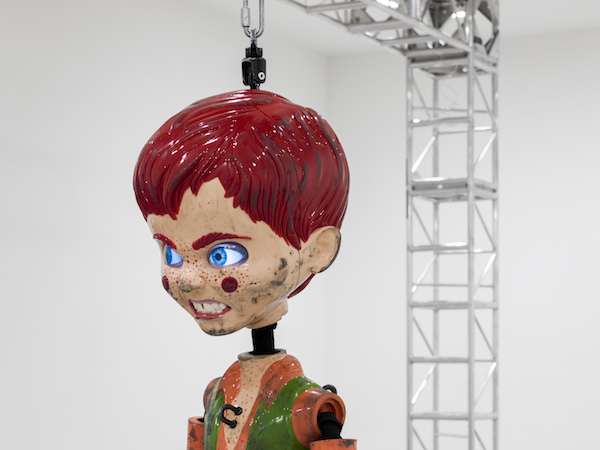
For those whose fantasy is to watch Howdy Doody be tortured.

Ben Davis

Jordan Wolfson’s art delights me a little—which may be a strange thing to say for an artist whose most recent installation centers on a human-like robot being brutally tortured for the entertainment of its spectators.
But Wolfson (b. 1980) delights me because I have this hypothesis that contemporary art—one of its strands, at least, particularly the neo-Koonsian strain of which Wolfson is an enthusiastic partisan—is developing an identity that can best be described as adult theme-park entertainment. And Wolfson’s creepy animatronic art happens to be a note-perfect illustration of how the circuit between the museum and the fairground will be closed.
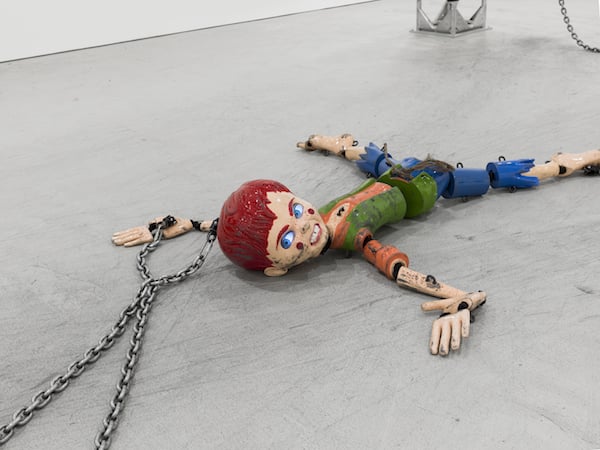
Jordan Wolfson, Colored sculpture (2016) Courtesy Sadie Coles HQ and David Zwirner
What you will see, if you go into David Zwirner gallery right now, is a floppy, gap-toothed marionette, suspended in the center of the gallery by chains. Its eyes are animated, and equipped with sensors so that they seem to gaze at the audience.
Over the course of about 20 minutes, the mechanisms controlling the chains winch in and out, manipulating the puppet. Sometimes, in a moment of dangling calm, the puppet will just hang there, its cartoon eyes rolling stupidly over the crowd.
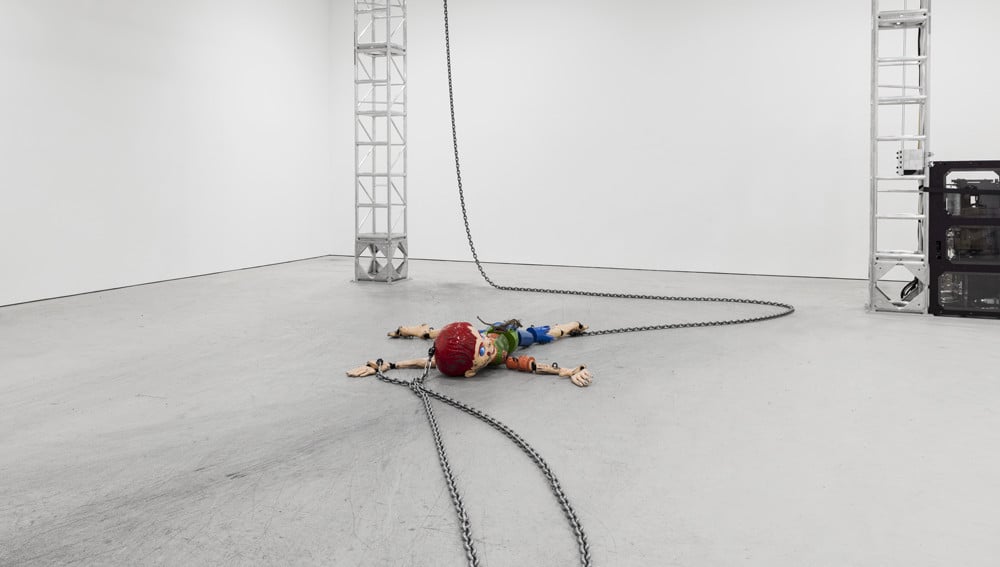
Jordan Wolfson, Colored sculpture (2016). Mixed media, overall dimensions vary with each installation. Courtesy Sadie Coles HQ, London and David Zwirner, New York.
In one of these moments, a monotone male voice issues from the doll. It begins to count upwards, enumerating a fragmented list that alternates pleasant and hateful thoughts about a loved one: “…four to leave you; five to touch you; six to move you; seven to ice you; eight to put my teeth in you; nine to put my hand on you; ten to put my hand in your hair…”
Sometimes, the chains will violently twists the limbs, or drop it against the floor, the puppet’s head smashing against the surface with a brutal clack, before he is dragged around the floor in a frenzy. At one point, the installation bursts with the plaintive chorus of Percy Sledge’s 1966 heart-tugger When a Man Loves a Woman, the cue for the apparatus to commence its frenzied attack on the doll with particular intensity.
Colored sculpture, as the piece is innocuously called, is the sequel to Wolfson’s first animatronic artwork, (Female figure) (2014). Realized with a reported half-million-dollar investment from Zwirner, and with the expertise of a state-of-the-art special effects house, Spectral Motion, that work centered on the figure of a robotic stripper who gyrated with realistic sexuality but was adorned with a heinous witch mask, giving the whole thing the vibe of a high-tech erotic nightmare.
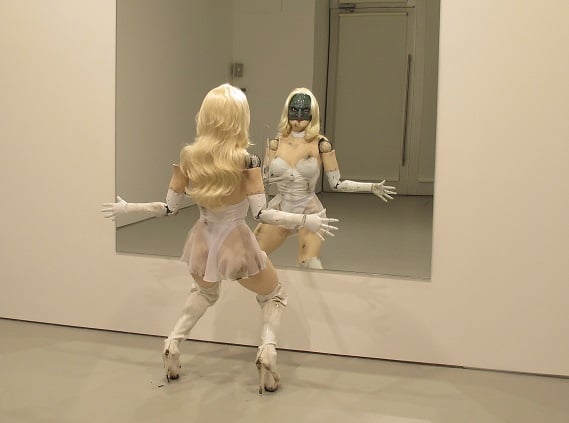
Jordan Wolfson’s Female Figure (2014)
Photo: artnet News.
Before that, Wolfson had already found considerable success with unsettling video works. Writing of one of these, Roberta Smith enthused that it “rejuvenates appropriation art through the incisive use of digital animation.” (Female figure), however, was his first foray into out-and-out robotics, and it was a huge, huge hit, catching the same zeitgeist as the incomparable AI parable Ex Machina or those terrifying viral videos of the military-grade robots by Boston Dynamics.
Colored sculpture shares a lot with (Female figure): a glum, intermittent voiceover that suggests, without coherently resolving into, a traumatic narrative; the fragmentary bursts of pop music that both lend emotion and a sense of malfunctioning entertainment; an affect of nastiness; above all, a level of technical sophistication not often seen in an art gallery.
It’s interesting to ask whether it is meaningful as well as memorable—though “meaning” is a concept to which Wolfson is avowedly hostile.
Two influences explain Wolfson’s turn to animatronic art. One was a trip to the Hall of Presidents at Disney World in 2012. He has said that he wanted these artificial bodies to capture the uncanny thrill he experienced in front of Robo Barack Obama.
He himself, however, will insist that the theme-park vibe is not what he is after. “This artwork isn’t inspired by Disney World, or a trip to Disney World, or anything that exists in Disney World,” he told Rozalia Jovanovic of (Female figure). “This work is about a physicality I experienced within my own body in relation to a third body, an artificial body.”
The second influence is his ongoing exploration of the legacy of Jeff Koons, known for ultra-high-production, ultra-shiny sculptures, and Wolfson’s avowed idol. With (Female figure), Wolfson has said that both the begrimed sexuality and the way the artwork confronts the viewer’s gaze with its own were inspired by his observations about what made Koons’s pornographic “Made In Heaven” works effective.
In terms of subject matter, Colored Sculpture would seem to swap one Koonsian obsession—the curdled cheesecake of “Made In Heaven”—for another: the psychically charged childhood paraphernalia of Koons’s “Banality” series. True, Wolfson’s outwardly aggro vibe is very far from Koons’s celebratory bombast. But then, when you listen to Wolfson himself defend the meaning of his work, it sounds almost perfectly like Koons’s storied self-help-ish patter about daring to be post-critical.
“The intention is a positive one—all the works have very positive intentions behind them,” Wolfson says. “They’re not about hatred and they don’t propagate hatred. I think they’re about witnessing culture. It’s like, I consider myself a witness to culture and not a judge.”
Elsewhere, Wolfson has gone so far as to fondly recall nestling under the covers as a boy and studying the 1994 monograph, Jeff Koons: Sculptor, claiming that Koons’s aphorisms “opened me up to a state of non-judgment.”
Such a post-meaning, post-critical, non-judgmental mindset might seem to offer a challenge when it comes to judging whether an artwork is successful or not. During a (rather perplexing) appearance on a panel about “The Koons Effect” at the Whitney in 2014, Wolfson proposed his own answer to this conundrum, albeit a cryptic one. He argued that later Koons works fail because “the image dominates the material,” and they become mere spectacles.
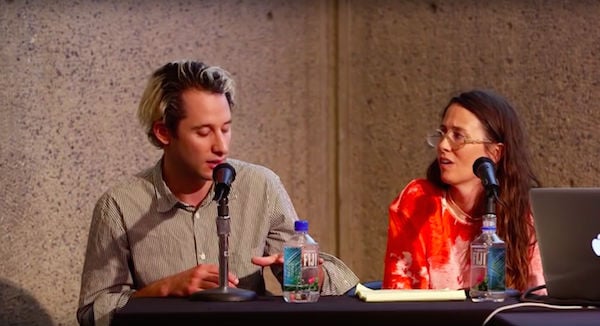
Jordan Wolfson explaining his theory of art on “The Koons Effect” panel at the Whitney, with a perplexed Laura Owens. Image: Whitney YouTube
Well, W magazine offers the following chirpy assessment of the meaning of Colored sculpture: “While the metal chains that drag the bot thrashing from floor to ceiling sure look painful, don’t worry, it’s all for a good cause: to land you a memorable Instagram.”
Is that backhanded compliment fair? From another angle, the theatrical creepiness of Wolfson’s animatronics may simply mean that he is a particularly good reader of the subtext of Jeff Koons’s art. The Zwirner show makes me think of Peter Schjeldahl’s analysis of the unexpectedly dark atmosphere that came to the surface when Jeff Koons tried his hands at curating a few years ago, in the exhibition “Skin Fruit” at the New Museum.
“Koons is famous for a public persona of relentlessly smiley, Amway-salesman unctuousness,” Schjeldahl wrote. “But ‘Skin Fruit’ makes clear to me that his deepest passion is anger, provoked by situations over which he has no control. The object of that anger, like the proverbial aim of standup comedians, is to ‘kill.’”
That, I think, may offer the best reading of the violence in Wolfson’s work: Its real meaning is the violent need to command your attention. The drama of the art is its demonstration of what it takes to do that.
Jordan Wolfson, “Colored sculpture” is on view at David Zwirner, through June 25, 2016.